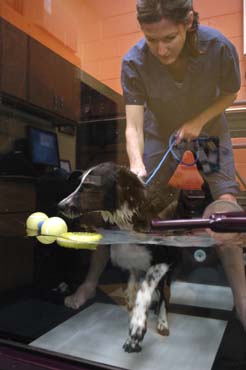Underwater treadmill benefits patients at Vet School
Reupert, a beagle who could not walk immediately following surgery for a herniated spinal disk, was the first patient to benefit from the University of Wisconsin–Madison School of Veterinary Medicine‘s new underwater treadmill therapy.
Though still wobbly, Reupert trotted over to greet Courtney Arnoldy, the school’s certified canine rehabilitation practitioner, by the start of his fifth post-surgery rehabilitation therapy session.

Canine physical therapist Courtney Arnoldy works with Stella, a year-old border collie, on an underwater treadmill. Stella is a stray belonging to the Wisconsin Border Collie Rescue. She suffers a malunion of her femur—a previous broken bone rotated in the socket and healed incorrectly. The treadmill, acquired by the School of Veterinary Medicine in May, uses water to support a dog’s weight as it walks and is used to help dogs regain leg use after orthopedic or neurologic problems, or surgery. In this case, the goal of physical therapy, says Arnoldy, is “to give the dog enough range of motion for the leg to be functional, and then she’ll start using it on her own and build up muscle mass.”
Photo: Michael Forster Rothbart
Arnoldy notes that the underwater treadmill, which was installed in May and was part of Reupert’s comprehensive therapy plan, helped speed his recovery.
The 4-by-6-foot see-through tank provides buoyancy and sensory input that can assist and improve a patient’s balance, movement and muscle strength while recovering from ailments including neurological problems, orthopedic problems and surgery.
“He’s doing very well,” Arnoldy agreed with Reupert’s owner as she carried her patient into the tank, closed the watertight door and waited for the water to rise to mid-chest level. As she started the treadmill, she encouraged the beagle to move forward while gently guiding his legs to help him learn to move them correctly.
The support provided by the water allows some patients to start rehabilitation sooner.
Therapeutic techniques are determined based on an individual assessment. Often, dogs that have had spinal injury need to relearn how to walk, and gentle hand manipulation on the treadmill helps train their neuromuscular system.
“It’s different than swimming, as it is more controlled, functional and predictable,” Arnoldy says.
She’s pleased to have the treadmill as part of her treatment options. Though donors paid for the new piece of equipment in 2004, the school first had to find a place to put it. Purchase of a more compact CT imaging unit allowed the hospital to carve one big room into two smaller ones. Construction of the new physical therapy room, complete with underwater treadmill, was completed in May.
One of the treadmill donors notes that her Rottweiler, who tore both anterior cruciate ligaments, could have started rehabilitation sooner if an underwater treadmill had been available at the time. Knowing that other animals in similar situations would benefit motivated her to contribute to the treadmill purchase.
Already, the treadmill has helped Reupert get back on his feet sooner. And Arnoldy predicts that many others will follow in his footsteps.
Tags: research
